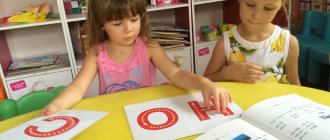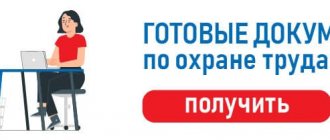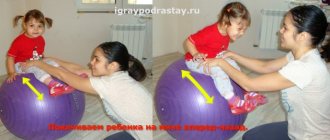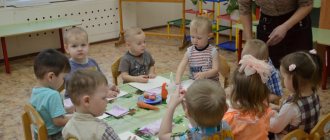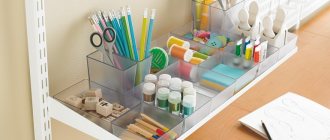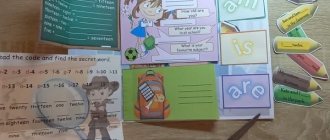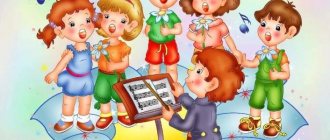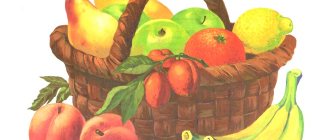Primary school teachers are well aware that young students come to school with completely different levels of preparation. And the better it is, the more confident the child feels in class, and the faster and easier the material is learned. However, you won’t be able to prepare well for school quickly. Even from kindergarten, with the help of games, it is necessary to develop the thinking processes of children, and later, through developmental activities with children already 4-5 years old, you can master the basics of literacy and mathematics.
Any parent can handle the preparation of a future schoolchild; the main thing is to know what knowledge and skills to teach at 4-5 years old, and how to turn home schooling into a “system.”
What tasks are suitable for children 4-5 years old?
In the article: “Organization of developmental activities for children 3-4 years old at home,” it was already written about what a preschool child should know at 4 years old. Now you need to work on the same skills, deepening your knowledge and complicating tasks. A small list of what a baby will learn in the fifth year:
- use of prepositions;
- orientation in space (know left/right, etc.);
- understand where “more”, “equally” or “less”;
- use nouns according to numbers;
- Count to 10, to 5 - in reverse order.
- draw lines without lifting the pencil from the paper, etc.
If your preschooler is already coping with this, don’t stand still and deepen your knowledge. However, all classes should be interesting to him, otherwise excessive workload will only discourage him from studying for a long time.
Developmental aids 4+
Now about the tasks themselves. For children 4 years old you can find many printed publications, the exercises of which will not only help fill the lessons themselves, but will also tell you in which direction to move.
The most popular are the series of manuals by O.N. Zemtsova “Smart Books”, as well as the publication “School of the Seven Dwarfs”. Such textbooks contain tasks for the development of logical thinking, attention, plot pictures, games with stickers, and much more. etc.
An example of an illustration with tasks in mathematics and logic from the “Literacy” series.
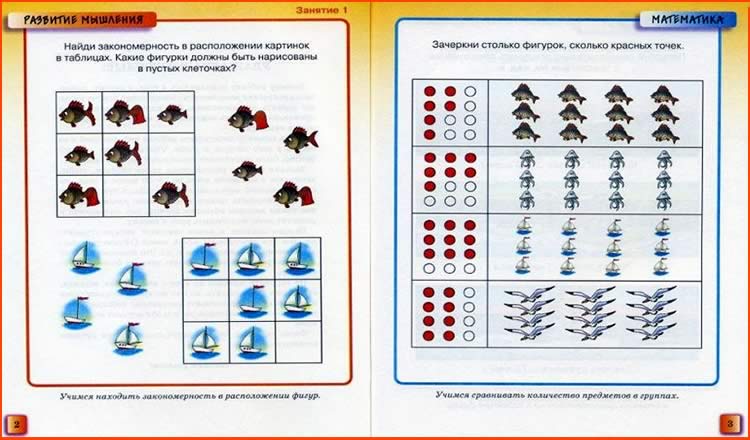
For children 4 years old, the first copybooks are also suitable. By tracing simple patterns along the dots, children prepare their hands for writing. An example from the School of the Seven Dwarfs.
Reading ABCs and math books
If the baby is willing to study and is successful, the main subjects - literacy and mathematics - can be studied using real textbooks.
For teaching reading, Zhukova’s “Primer Book” is considered one of the best, which clearly shows how letters merge into syllables, and the methodology itself corresponds to school curricula.
Thematic material:
- Educational board games for children 6 years old
- How to teach a child to read syllables
The Buneevs’ technique is also popular. At the age of four, the authors offer children the guide “On the Road to the ABCs.”
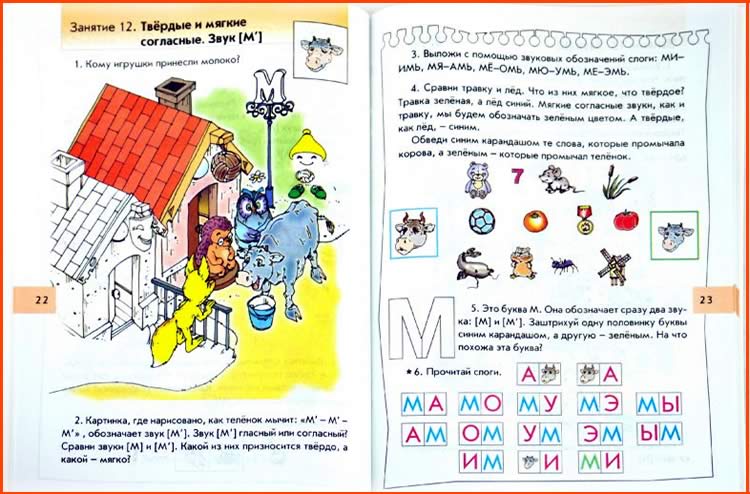
Also, primary school teachers highly value textbooks on mathematics by L.G. Peterson. For preschoolers there is an age-appropriate textbook called “Igrachka”. With it, already at the age of 4, a child will learn all the necessary topics in a playful way.
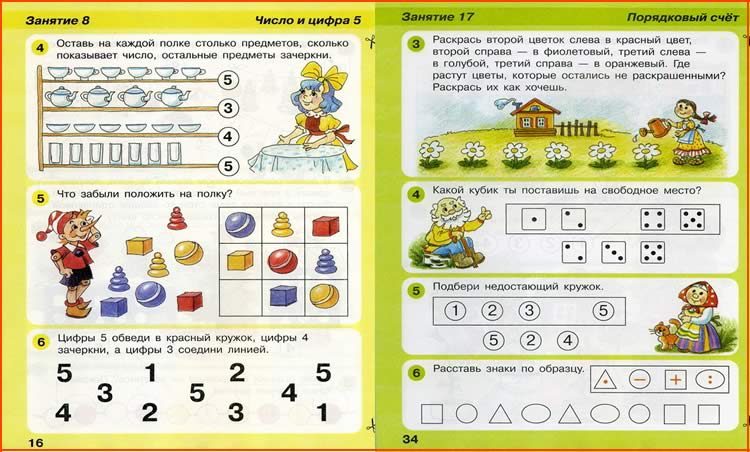
Tasks in pictures
In addition to manuals, you can use printed pictures with exercises during classes.
Studying right and left
To help your child remember which hand is right and which is left, you can use a poster with palms.
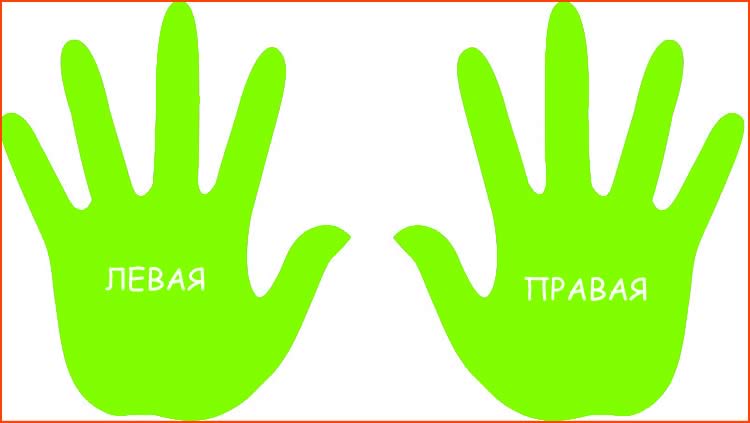
Pictures in which you need to circle the images with the desired direction will also help.
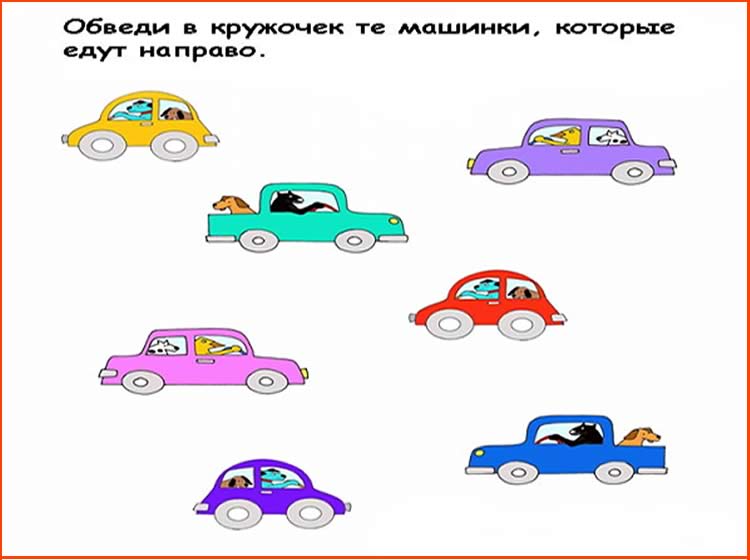
Mathematics
Coloring pages in which you need to connect the dots in order will help you consolidate your knowledge of the number series.
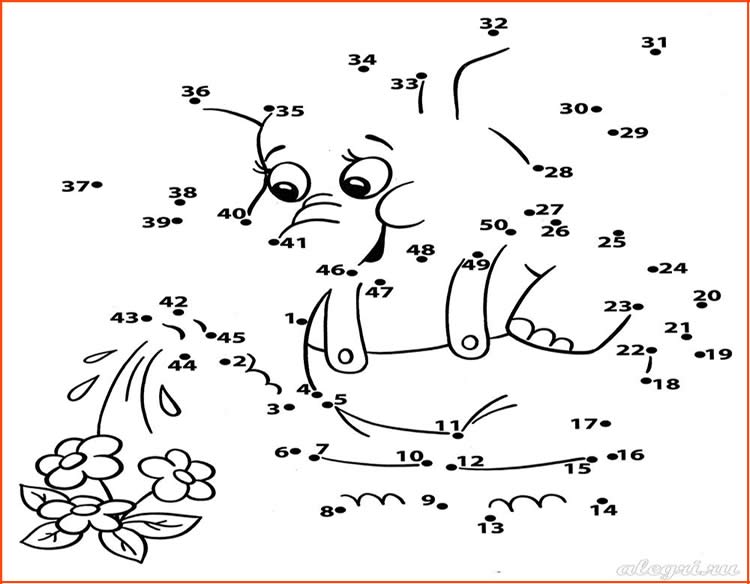
And such mathematical material will teach you how to correlate quantity with number.
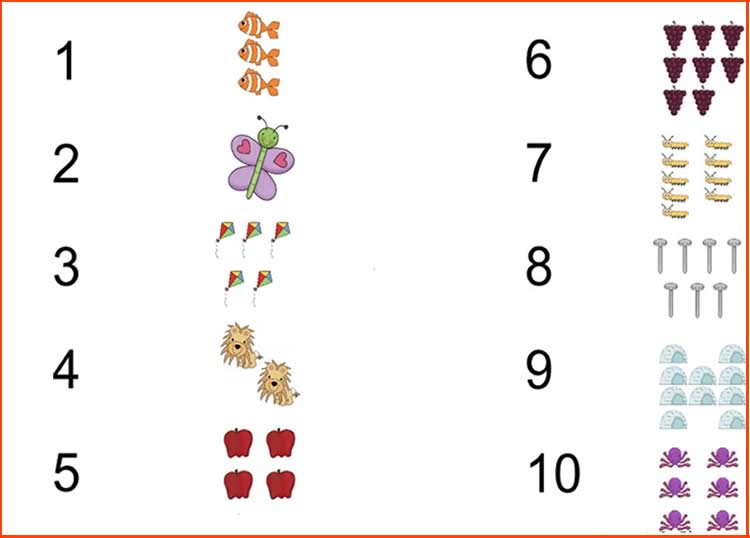
Speech development
You can use the pictures to answer questions and write short stories.
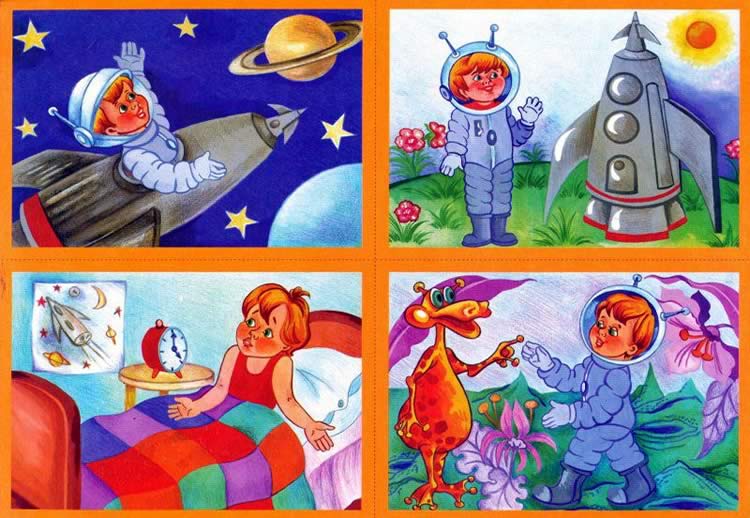
Logics
To develop logical thinking, you can prepare the game “Find a Pair”.
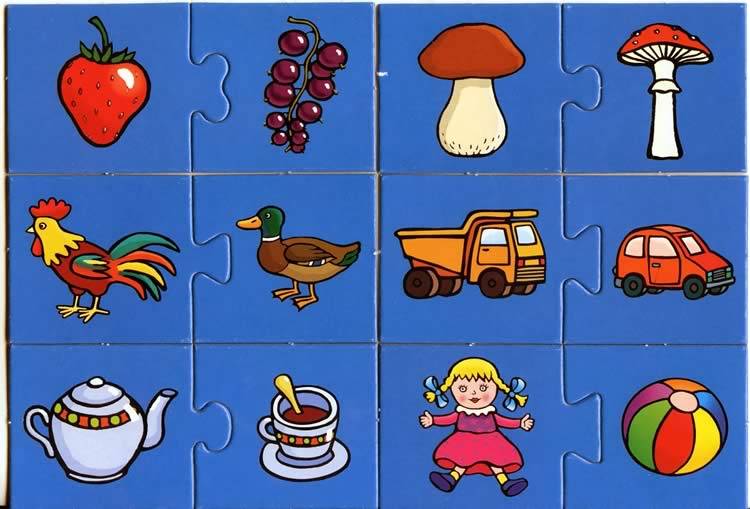
Or finish a logical series.
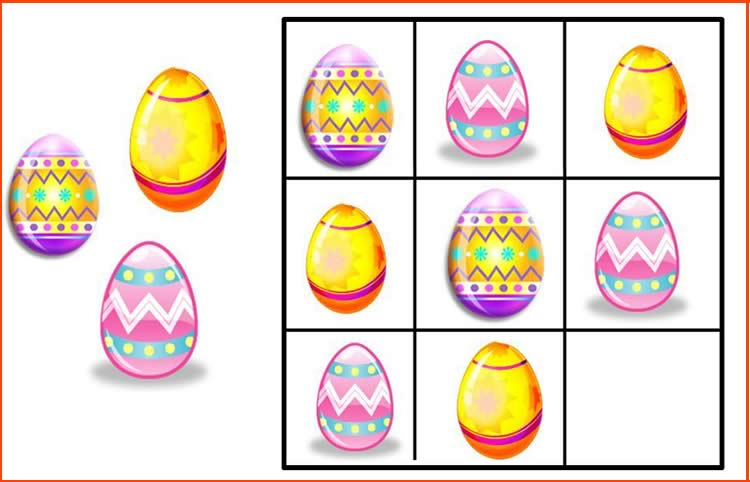
Pictures for a lesson about space
A home lesson can also be thematic. After familiarizing yourself with the topic “Space,” you can offer your child various games to develop thinking processes.
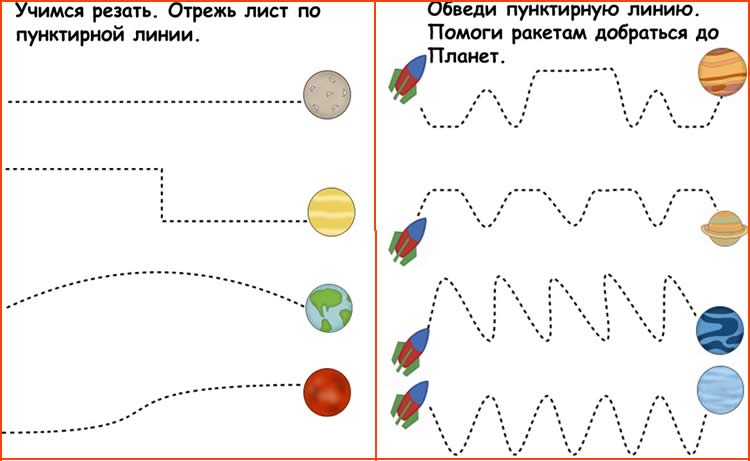
Exercises and games
At four years old, all exercises should be of a playful nature only. Otherwise, the baby will quickly get tired and lose interest in learning.
For example, to develop memory, draw a grid with large cells on paper. Then, together with the baby, place several small toys in square houses. When the child turns away, move the objects to other cells. Invite your preschooler to return them to their places.
The “Book Detective” exercise will help consolidate knowledge of letters and the ability to isolate the first sound in a word. Assignment: guess a letter and ask you to find an object or picture in a book for a given letter. With several children you can play for speed. You can complicate the exercise with a task, find words with two letters or with a letter at the end.
Another game for literacy lessons. Glue cards with letters to objects in the room so that their names begin with that letter. The baby's task is to find which letters are attached incorrectly and correct it.
It’s good when parents are seriously involved in the development and education of their preschool children. However, you should not turn homework into a chore for your child or a chore. The child should enjoy the learning process and look forward to each lesson.
What have I done for myself?
The application of the Montessori method begins not with the child, but with the parents. To understand how to develop a child at 4.5 years old and create a favorable environment at home, you first need to work on yourself. Because a parent who is not a resource is not capable of much.
Previously, every free 5 minutes I was distracted by chats that had nothing to do with my development. Now the realization has come that this is an empty exercise that takes a lot of time. But it can be spent usefully: loading the dishwasher and washing machine, clearing the table, hanging laundry, vacuuming, watching children, writing down your thoughts.
If the children see me just sitting and drinking tea, they will drop what they are doing and come running. The same thing will happen if I lie down. Therefore, it is wisest to devote time to the home, and at the same time involve the children. It's no more difficult than chatting, but it's so useful.
Here are a few other small achievements that have significantly improved the quality of my life:
- During the course, I became acquainted with the graph of emotions and each of them separately. Now I can control myself better; this is a valuable skill when communicating with children.
- I learned to find time for myself. At least once a week, my husband and I go out on business or for a walk, and leave the children with their grandmother - they are already old enough. After three such weeks, I learned to concentrate on myself and get proper rest.
- I communicate with Montessori mothers in the alumni chat. We discuss what new things we have learned, what books we have read - and so we develop together. This is my point of interest and source of inspiration.
I learned the habit of not cleaning when the children are asleep immediately after the birth of my daughter. At such moments I sleep, watch webinars, films. I start “my” time with a cup of coffee, something tasty and a languid look out the window.
I want the children to see their mother happy and beautiful. The hardest thing was to realize that I was the main part of the developing environment for children. I created conditions under which it became easier for children to develop and explore the world, but I forgot about myself: this applied to both internal and external resources. Even my husband began to be indignant that I spend the money he gives me on children. I began to change and allow myself what I had denied for a long time. Whether it's cakes, a new shampoo, a trip to a beauty salon or cafe, a walk.
Memory is not only visual
It is human nature to remember what he sees, hears and does. Therefore, memory development should be aimed at all of these aspects.
- Visual memory is well trained by looking at pictures with their subsequent description, as well as remembering the location of objects in the room. You can ask your child what he was wearing yesterday. Develops visual memory by playing to rearrange toys: several objects are placed, and when the child turns away, they are swapped. The preschooler's task is to guess what has changed.
- Auditory memory is trained by learning nursery rhymes and rhymes. It is advisable to learn four lines a day. It is imperative to retell fairy tales and share impressions of what you saw, and everything needs to be told in detail. You can also give your child play tasks: buy in a “store” according to an oral list or set the table according to certain instructions, also spoken orally.
- Motor memory is trained during games in which you need to repeat the movements of adults. Once a certain game is learned, an adult can “accidentally” make a mistake; the child’s task is to find and correct the mistake.
Games to improve memory and attention
Many children of senior preschool age are restless (this is especially true for boys). Hyperactivity can negatively impact learning. It is important to carry out activities that increase focus, concentration and improve memory.
The following games are suitable for improving memory and attention:
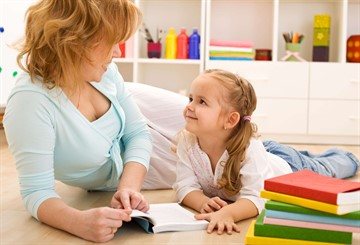
- "Less - more". Makes the baby more intelligent. The idea is to name different words and suggest making them “big” or “small”. For example, hare - hare - bunny, house - house - house;
- "What is the name of?" . The game trains thinking, speech, intelligence, and memory. You need to describe some animal, plant, or object to the child and ask him to guess what he is talking about. For example, a clock that helps you wake up (alarm clock), a large spoon for stirring soup (ladle). You can change roles with your child;
- “What to whom?” . Develops logic and intelligence. The essence of the lesson is to name the child an animal or a person of a certain profession and ask him to say an object that may be useful to him.
Interesting drawing lessons
Children of senior preschool age love to draw. They already have skills in handling brushes and paints, felt-tip pens, and pencils. Drawing develops speech, fine motor skills, imagination, perseverance, and attentiveness.
To teach your child to depict various objects, you can use the following methods:
- tracing figures with a dotted outline. The child will remember the shapes of different objects;
- use of coloring books;
- carbon copy drawing (outlining already prepared images and then coloring them).
When teaching a child to draw, you need to use simple lines and geometric shapes. There are many interesting lessons.
Master class on depicting a deciduous tree:
- draw a tubercle at the bottom of the sheet;
- above it (at the top of the paper) draw a circle;
- connect two objects with straight lines (this is a trunk);
- draw branches;
- give the edge of the crown unevenness (highlight those places where the branches enter);
- Draw grass on the hillock.
Other knowledge
A preschooler needs to develop, for example, geographical knowledge (concepts about living and inanimate nature, seasons).
It is recommended to read encyclopedias more often, look at globes or geographical maps. It is worth noting that geography is one of the most important sciences for a 4-5 year old child. By studying this science, a preschooler will find answers to many questions of interest.
Show your child paintings by Russian artists, describe every detail, its origin and purpose.
Speech therapy lesson plan
By the age of five, children should fully master the system of their native language: speak coherently, express their thoughts clearly, construct complex sentences, retell fairy tales, pronounce all sounds correctly.
If a child has speech impairments, he will make mistakes in the lexical-grammatical, phonetic-phonemic structure. These children have a limited vocabulary and cannot form complex or simple sentences. Babies' speech may be incoherent.
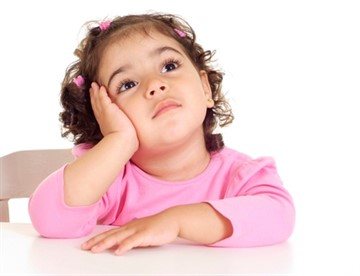
There are many reasons for deviations:
- memory impairment, absent-mindedness;
- weakness of the muscles of the articulatory organs;
- problems with fine motor skills;
- unformed verbal-logical, visual-figurative thinking.
To solve speech problems, speech therapy sessions are conducted. The lesson program should be developed by a specialist. Parents can do simple exercises at home.
Conditions for correcting the phonetic-phonemic system:
- compliance by family members with stylistic, spelling and grammatical forms when using speech;
- creation of a complete speech environment. Parents should communicate a lot and often with each other in the presence of the child;
- development of auditory function;
- encouraging children to imitate the object and speech actions of adults.
Parents are able to help children enrich their vocabulary, master the correct grammatical structure of speech, and improve their sound culture.
Speech therapy classes should take into account the following rules:
- regularity;
- perform exercises in a playful way to interest the child;
- Praise your child for his achievements. Don't scold him if he shows bad results.
To improve speech, finger games and articulatory gymnastics are used.
A speech therapy lesson plan may look like this:
- psychological mood;
- analysis of letters and sounds of words;
- sound production;
- automation of sound in speech;
- finger games.
How to teach a child to read and write?
Pediatricians believe that the sooner a child learns to read, the higher his intelligence will be. Prestigious schools usually enroll those children who have already mastered the basics of literacy. Therefore, it is useful for parents to start teaching their 4-5 year old child to read and write.
You need to purchase a colorful ABC book. It is worth choosing large format publications: they better attract the attention of children.
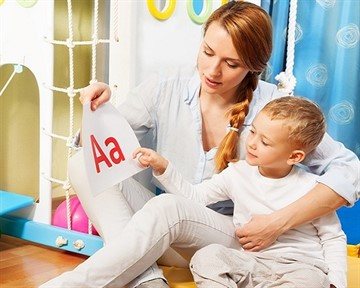
The letters should be studied in this order:
- hard vowels (a, e, u, s, o);
- hard voiced consonants (m, l);
- voiceless and hissing consonants (w, t, k, zh, d);
- rest.
The first thing you need to do is learn the alphabet. In one lesson you need to get acquainted with one letter. The next lesson should begin with a repetition of the previously discussed letters. Then you can start reading simple syllables (ma, la, pa).
In order for the baby to understand how a syllable is formed, you need to tell him that the consonant letter “runs” towards the vowel, “catch up” with it. After such an explanation, most children begin to pronounce two letters together. Next they move on to reading complex syllables.
Writing is difficult for many children. The ability to write in most cases depends on the development of finger dexterity, coordination of movements, patience, and perseverance. Therefore, it is important to pay attention to developing these skills.
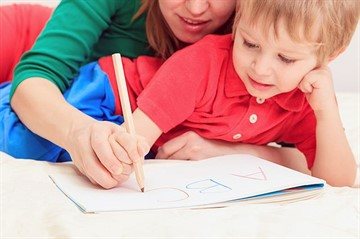
It is recommended to use special attachments for pens and pencils. They help to hold the writing object correctly. There are attachments for left-handed and right-handed people.
It is worth using copybooks in which the child needs to trace different contours and shapes. From the age of five, you can teach your child to write in block letters. You should start with simple letters (o, s, l). Next you need to start writing complex letters.
To consolidate skills, it is recommended to regularly ask your child to write his name.
Educational cards and other useful materials
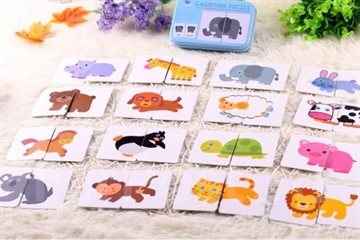
To replenish the vocabulary, develop speech, and study numbers and letters, special cards are used. They come in different themes (“Alphabet”, “Birds”, “Animals”, “Numbers”, “Transport”, “Nature”, etc.).
Other developmental materials include:
- coloring books;
- special posters;
- children's books (fairy tales, primers).
conclusions
So, 4 years is a period of discovery, both for the baby and for his parents. A four-year-old child actively learns about himself and the world, his abilities and talents manifest themselves. The skills acquired earlier continue to be improved. The child’s intensive physical, mental and personal development occurs: the baby learns to control his body and emotions, memory, attention, thinking, speech and imagination develop. Four-year-olds simply need to communicate with their peers, because the development of children occurs mainly in role-playing games.

